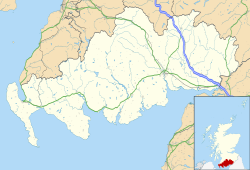Clachanmore
| |
|---|---|
Location within Dumfries and Galloway | |
| Population | 20 estimate |
| Council area | |
| Lieutenancy area | |
| Country | Scotland |
| Sovereign state | United Kingdom |
| Post town | Stranraer |
| Postcode district | DG9 |
| Dialling code | 01776-860 |
| Police | Scotland |
| Fire | Scottish |
| Ambulance | Scottish |
| UK Parliament | |
| Scottish Parliament | |
Clachanmore is a village in the South Rhins of Galloway near Ardwell in the south west of Scotland. It has also been known as Low Ardwell. [1]
The name of the village means 'big village' (Clachan Mòr, in Gaelic) and may derive from a stone circle that formerly stood there; [2] there are remains of a circular enclosure on Barrack Knowe near High Clachanmore farmhouse. [3]

Clachanmore school is the most prominent building in the village. The building dates to 1831 [4] and was the school for Ardwell. There is a small schoolmaster's house next door. Until 2003 it was an art gallery; it is now a private house.
